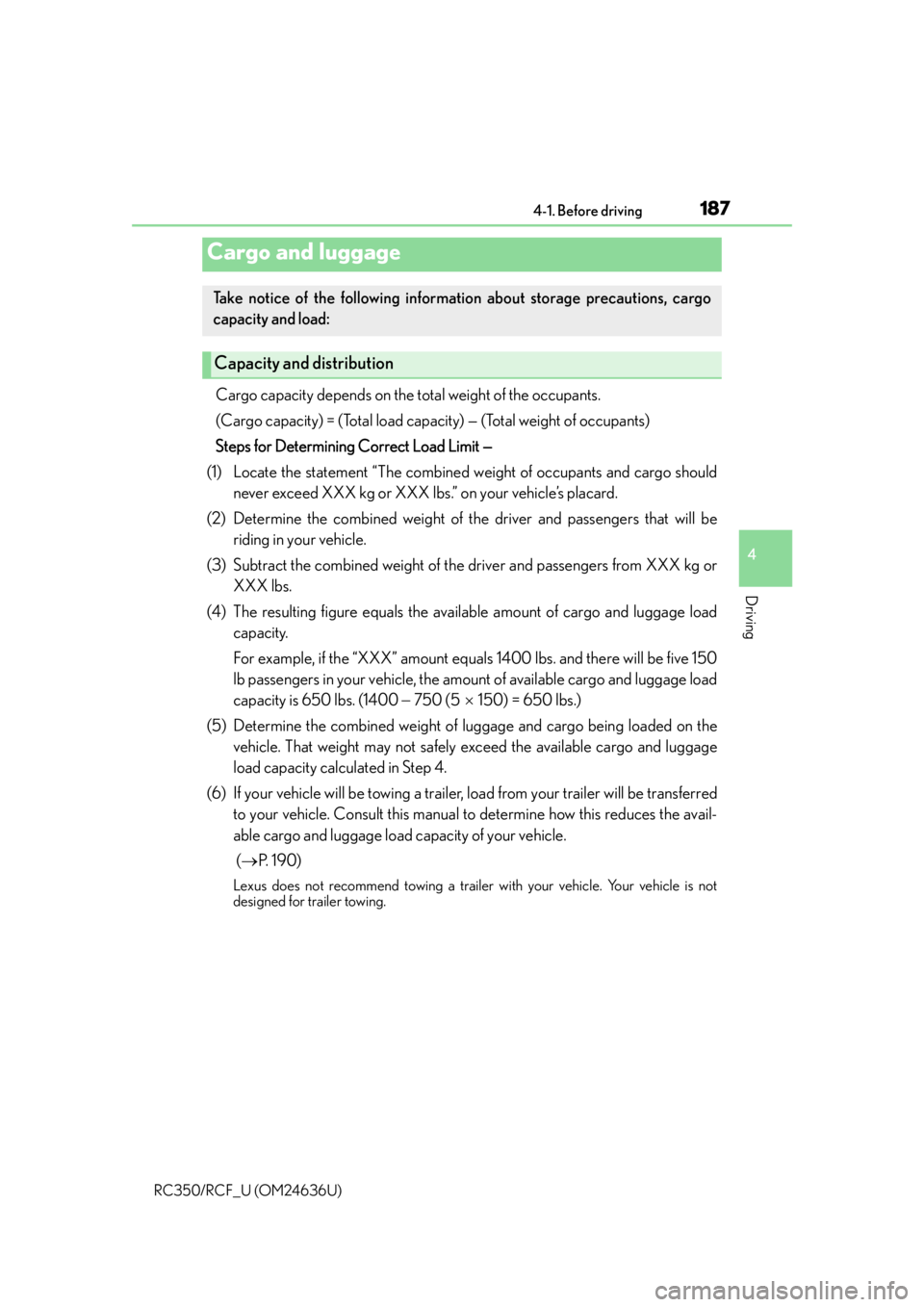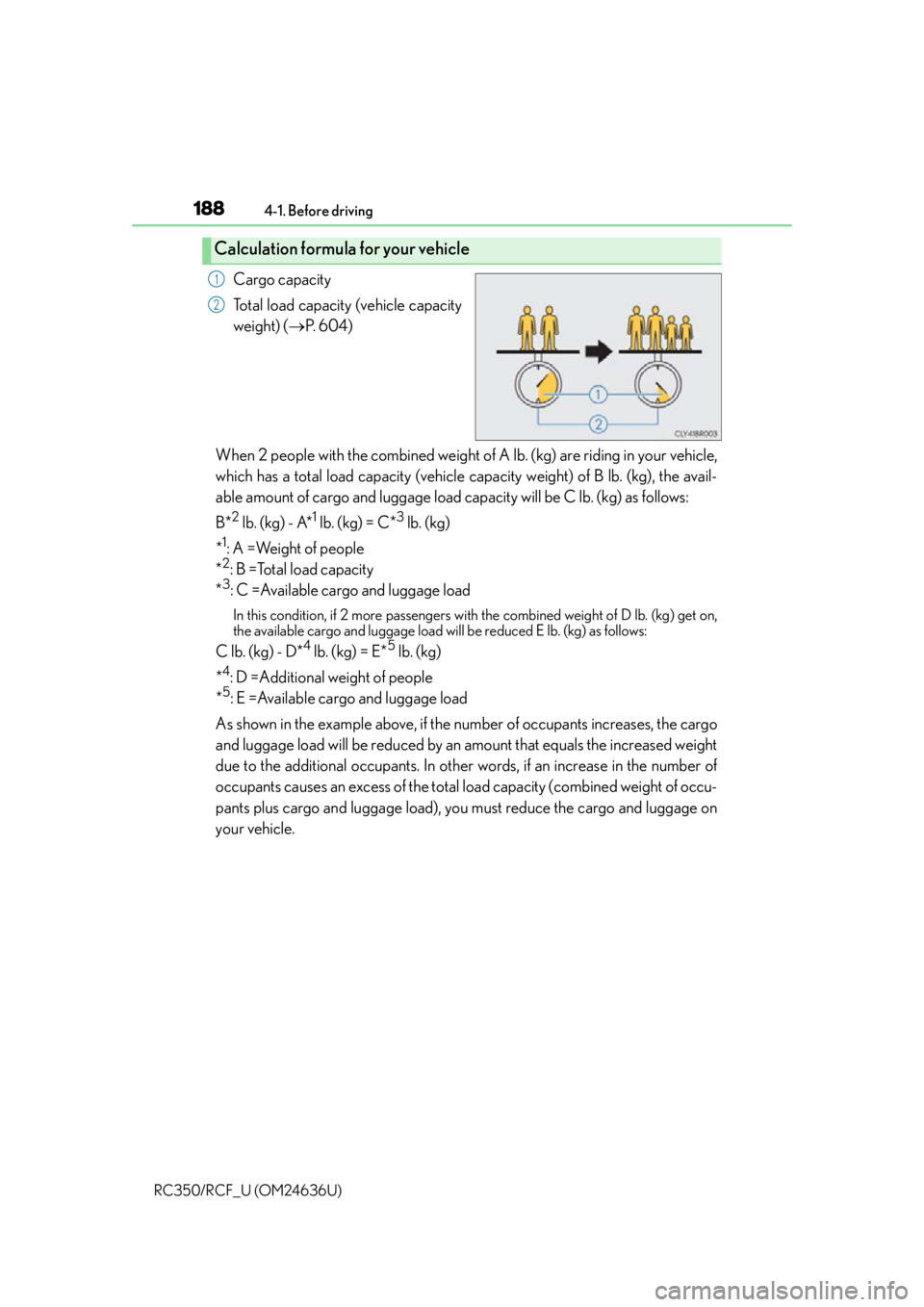load capacity LEXUS RC F 2015 Owners Manual
[x] Cancel search | Manufacturer: LEXUS, Model Year: 2015, Model line: RC F, Model: LEXUS RC F 2015Pages: 684, PDF Size: 9.31 MB
Page 187 of 684

1874-1. Before driving
4
Driving
RC350/RCF_U (OM24636U)
Cargo capacity depends on the total weight of the occupants.
(Cargo capacity) = (Total load capacity) — (Total weight of occupants)
Steps for Determining Correct Load Limit —
(1) Locate the statement “The combined weight of occupants and cargo should never exceed XXX kg or XXX lbs.” on your vehicle’s placard.
(2) Determine the combined weight of the driver and passengers that will be
riding in your vehicle.
(3) Subtract the combined weight of the driver and passengers from XXX kg or
XXX lbs.
(4) The resulting figure equals the ava ilable amount of cargo and luggage load
capacity.
For example, if the “XXX” amount equals 1400 lbs. and there will be five 150
lb passengers in your vehicle, the am ount of available cargo and luggage load
capacity is 650 lbs. (1400 ď€ 750 (5 ď€ ď‚´ď€ 150) = 650 lbs.)
(5) Determine the combined weight of luggage and cargo being loaded on the
vehicle. That weight may not safely exceed the available cargo and luggage
load capacity calculated in Step 4.
(6) If your vehicle will be towing a trailer, load from your trailer will be transferred
to your vehicle. Consult this manual to determine how this reduces the avail-
able cargo and luggage load capacity of your vehicle.
( ď‚® P. 1 9 0 )
Lexus does not recommend towing a trailer with your vehicle. Your vehicle is not
designed for trailer towing.
Cargo and luggage
Take notice of the following information about storage precautions, cargo
capacity and load:
Capacity and distribution
Page 188 of 684

1884-1. Before driving
RC350/RCF_U (OM24636U)
Cargo capacity
Total load capacity (vehicle capacity
weight) ( ď‚®P. 6 0 4 )
When 2 people with the combined weight of A lb. (kg) are riding in your vehicle,
which has a total load capacity (vehicle capacity weight) of B lb. (kg), the avail-
able amount of cargo and luggage load capacity will be C lb. (kg) as follows:
B*
2 lb. (kg) - A*1 lb. (kg) = C*3 lb. (kg)
*
1: A =Weight of people
*2: B =Total load capacity
*3: C =Available cargo and luggage load
In this condition, if 2 more passengers with the combined weight of D lb. (kg) get on,
the available cargo and luggage load will be reduced E lb. (kg) as follows:
C lb. (kg) - D*4 lb. (kg) = E*5 lb. (kg)
*
4: D =Additional weight of people
*5: E =Available cargo and luggage load
As shown in the example above, if the number of occupants increases, the cargo
and luggage load will be reduced by an amount that equals the increased weight
due to the additional occupants. In other words, if an increase in the number of
occupants causes an excess of the total load capacity (combined weight of occu-
pants plus cargo and luggage load), you must reduce the cargo and luggage on
your vehicle.
Calculation formula for your vehicle
1
2
Page 189 of 684

1894-1. Before driving
4
Driving
RC350/RCF_U (OM24636U)
WA R N I N G
â– Things that must not be carried in the trunk
The following things may cause a fire if loaded in the trunk:
â—ŹReceptacles containing gasoline
â—ŹAerosol cans
â– Storage precautions
Observe the following precautions.
Failure to do so may prevent the pedals from being depressed properly, may block the
driver’s vision, or may result in items hittin g the driver or passengers, possibly causing
an accident.
â—ŹStow cargo and luggage in the trunk whenever possible.
â—ŹRC350: To prevent cargo and luggage from sliding forward during braking, do not
stack anything in the enlarged trunk. Keep cargo and luggage low, as close to the
floor as possible.
â—ŹRC350: When you fold down the rear seats, long items should not be placed directly
behind the front seats.
â—ŹRC350: Never allow anyone to ride in the en larged trunk. It is not designed for pas-
sengers. They should ride in their seats with their seat belts properly fastened.
â—ŹDo not place cargo or luggage in or on the following locations.
• At the feet of the driver
• On the front passenger or rear seats (when stacking items)
• On the package tray
• On the instrument panel
•On the dashboard
• In front of the navigation system scre en (if equipped) or Lexus Display Audio
screen (if equipped)
â—ŹSecure all items in th e occupant compartment.
â– Capacity and distribution
â—ŹDo not exceed the maximum axle weight ra ting or the total vehicle weight rating.
●Even if the total load of occupant’s weight and the cargo load is less than the total load
capacity, do not apply the load unevenly. Improper loading may cause deterioration
of steering or braking control which may cause death or serious injury.
Page 190 of 684

1904-1. Before driving
RC350/RCF_U (OM24636U)
â—†Total load capacity (vehicle capacity weight): (ď‚® P. 6 0 4 )
Total load capacity means the combined weight of occupants, cargo and lug-
gage.
â—†Seating capacity: 4 occupants (Front 2, Rear 2)
Seating capacity means the maximum number of occupants whose estimated
average weight is 150 lb. (68 kg) per person.
â—†To w i n g c a p a c i t y
Lexus does not recommend towing a trailer with your vehicle.
â—†Cargo capacity
Cargo capacity may increase or decrea se depending on the weight and the
number of occupants.
â– Total load capacity and seating capacity
These details are also described on the tire and loading information label. (ď‚®P. 5 0 0 )
Vehicle load limits
Vehicle load limits include total load capacity, seating capacity, towing capac-
ity and cargo capacity.
WA R N I N G
â– Overloading the vehicle
Do not overload the vehicle.
It may not only cause damage to the tires, but also degrade steering and braking ability,
resulting in an accident.
Page 289 of 684

2894-5. Using the driving support systems
4
Driving
RC350/RCF_U (OM24636U)
WA R N I N G
â– When the TRAC/VSC systems are turned off
Be especially careful and drive at a speed appropriate to the road conditions. As these
are the systems to help ensure vehicle st ability and driving force, do not turn the
TRAC/VSC systems off unless necessary.
â– Expert mode precautions
â—ŹDo not use on public roads.
â—ŹUse only when the road conditions and safety of the surrounding area can be
ensured.
â—ŹProper use of expert mode requires a profes sional level of driving skill. When using
expert mode, always check the road conditions and surrounding area and drive more
carefully than usual.
â– Replacing tires
Make sure that all tires are of the specified size, brand, tread pattern and total load
capacity. In addition, make sure that the tires are inflated to the recommended tire infla-
tion pressure level.
The ABS, TRAC and VSC systems will not function correctly if different tires are
installed on the vehicle.
Contact your Lexus dealer for further information when replacing tires or wheels.
â– Handling of tires and the suspension
Using tires with any kind of problem or modi fying the suspension will affect the driving
assist systems, and may caus e a system to malfunction.
Page 495 of 684

4957-3. Do-it-yourself maintenance
7
Maintenance and care
RC350/RCF_U (OM24636U)
â– Maximum load of tire
Check that the maximum load of the replacement tire is greater than 1 /2 of the Gross
Axle Weight Ratings (GAWR) of either the front axle or the rear axle, whichever is
greater.
â– Tire types
â—ŹSummer tires
Summer tires are high-speed performance tires best suited to highway driving under
dry conditions. Since summer tires do not have the same traction performance as
snow tires, summer tires are inadequate for driving on snow-covered or icy roads. For
driving on snow-covered roads or icy roads, the use of snow tires is recommended.
When installing snow tires, be sure to replace all four tires.
â—ŹAll season tires
All season tires are designed to provide better traction in snow and to be adequate for
driving in most winter condit ions as well as for use year-round. All season tires, how-
ever, do not have adequate traction performance compared with snow tires in heavy
or loose snow. Also, all season tires fall short in acceleration and handling perfor-
mance compared with summer tires in highway driving.
â—ŹSnow tires
For driving on snow-covered roads or icy roads, we recommend using snow tires. If
you need snow tires, select tires of the same size, construction and load capacity as the
originally installed tires. Since your vehicle has radial tires as original equipment, make
sure your snow tires also have radial cons truction. Do not install studded tires without
first checking local regulations for possible re strictions. Snow tires should be installed
on all wheels. ( ď‚®P. 3 1 5 )
â– If the tread on snow tires wears down below 0.16 in. (4 mm)
The effectiveness of the tires as snow tires is lost. For the GAWR, see the Certification Label. For
the maximum load of the tire, see the load limit
at maximum cold tire inflation pressure men-
tioned on the sidewall of the tire. ( ď‚®P. 6 2 3 )
Page 503 of 684

5037-3. Do-it-yourself maintenance
7
Maintenance and care
RC350/RCF_U (OM24636U)
When replacing wheels, care should be taken to ensure that they are equivalent
to those removed in load capacity, diameter, rim width and inset
*.
Replacement wheels are available at your Lexus dealer.
*: Conventionally referred to as “offset”.
Lexus does not recommend using the following:
â—ŹWheels of different sizes or types
â—ŹUsed wheels
â—ŹBent wheels that have been straightened
â—ŹUse only Lexus wheel nuts and wrenches designed for use with your alumi-
num wheels.
â—ŹWhen rotating, repairing or changing your tires, check that the wheel nuts are
still tight after driving 1000 miles (1600 km).
â—ŹBe careful not to damage the aluminum wheels when using tire chains.
â—ŹUse only Lexus genuine balance weights or equivalent and a plastic or rubber
hammer when balancing your wheels.
â– When replacing wheels
The wheels of your vehicle are equipped with tire pressure warning valves and transmit-
ters that allow the tire pressure warning system to provide advance warning in the event
of a loss in tire inflation pressure. Whenever wheels are replaced, tire pressure warning
valves and transmitters must be installed. (ď‚® P. 4 9 2 )
Wheels
If a wheel is bent, cracked or heavily corroded, it should be replaced. Other-
wise, the tire may separate from the wheel or cause a loss of handling control.
Wheel selection
Aluminum wheel precautions
Page 630 of 684

6309-1. Specifications
RC350/RCF_U (OM24636U)
Glossary of tire terminology
Tire related termMeaning
Cold tire inflation pressure
Tire pressure when the vehicle has been parked for
three hours or more, or has not been driven more than 1
mile or 1.5 km un der that condition
Maximum inflation pres-
sureThe maximum cold inflated pressure to which a tire may
be inflated, shown on the sidewall of the tire
Recommended inflation
pressureCold tire inflation pressure recommended by a manu-
facturer
Accessory weight
The combined weight (in excess of those standard items
which may be replaced) of automatic transmission,
power steering, power brakes, power windows, power
seats, radio and heater, to the extent that these items are
available as factory-installed equipment (whether
installed or not)
Curb weight
The weight of a motor vehicle with standard equipment,
including the maximum capacity of fuel, oil and coolant,
and if so equipped, air co nditioning and additional
weight optional engine
Maximum loaded vehicle
weight
The sum of:
(a) Curb weight
(b) Accessory weight
(c) Vehicle capacity weight
(d) Production options weight
Normal occupant weight150 lb. (68 kg) times the numb er of occupants specified
in the second column of Table 1* that follows
Occupant distributionDistribution of occupants in a vehicle as specified in the
third column of Table 1
* below
Production options weight
The combined weight of installed regular production
options weighing over 5 lb. (2.3 kg) in excess of the
standard items which they replace, not previously con-
sidered in curb weight or accessory weight, including
heavy duty brakes, ride levelers, roof rack, heavy duty
battery, and special trim
RimA metal support for a tire or a tire and tube assembly
upon which the tire beads are seated
Page 631 of 684

6319-1. Specifications
9
Vehicle specifications
RC350/RCF_U (OM24636U)
Rim diameter
(Wheel diameter)Nominal diameter of the bead seat
Rim size designationRim diameter and width
Rim type designationThe industry manufacturer’s designation for a rim by
style or code
Rim widthNominal distance between rim flanges
Vehicle capacity weight
(Total load capacity)The rated cargo and luggage load plus 150 lb. (68 kg)
times the vehicle’s designated seating capacity
Vehicle maximum load on
the tireThe load on an individual tire that is determined by dis-
tributing to each axle its share of the maximum loaded
vehicle weight, and dividing by two
Vehicle normal load on the
tire
The load on an individual tire that is determined by dis-
tributing to each axle its sh are of curb weight, accessory
weight, and normal occupant weight (distributed in
accordance with Table 1
* below), and dividing by two
We a t h e r s i d eThe surface area of the rim not covered by the inflated
tire
BeadThe part of the tire that is made of steel wires, wrapped
or reinforced by ply cords and that is shaped to fit the
rim
Bead separationA breakdown of the bond be tween components in the
bead
Bias ply tireA pneumatic tire in which the ply cords that extend to
the beads are laid at altern ate angles substantially less
than 90 degrees to the centerline of the tread
CarcassThe tire structure, except tread and sidewall rubber
which, when inflated, bears the load
ChunkingThe breaking away of pieces of the tread or sidewall
CordThe strands forming th e plies in the tire
Cord separationThe parting of cords from adjacent rubber compounds
CrackingAny parting within the tread, sidewall, or innerliner of
the tire extending to cord material
Tire related termMeaning
Page 681 of 684

681Alphabetical index
RC350/RCF_U (OM24636U)
Tools................................................. 561, 575
Top tether strap........................................ 73
Torque Vectoring Differential (TVD) .......................................................313
Total load capacity ................................ 190
Towing Dinghy towing ...................................... 192
Emergency towing............................524
Towing eyelet....................................... 527
Trailer towing .......................................... 191
TRAC (Traction Control) ................. 282
Traction Control (TRAC) ................. 282
Trailer towing ............................................ 191
Transmission.............................................199 Automatic transmission ................... 199
Driving mode select switch ..........278
If the shift lever cannot be shifted from P .................................. 589
M mode ..................................................202
Paddle shift switches ............. 201, 202
Trip meters .........................................90, 96 Trunk .............................................................141
Internal trunk release lever ............. 143
Luggage security system................. 142
Smart access system with push-button start......................141
Trunk features...................................... 434
Trunk grip ................................................ 142
Trunk light................................................ 143
Trunk opener main switch .............. 142
Trunk opener switch ............................141
Trunk storage extension ................438
Wireless remote control....................141
Trunk light.................................................. 143 Wattage ...................................................619
Turn signal lights ................................... 204 Replacing light bulbs ................................. 514, 516, 519
Turn signal lever ................................. 204
Wattage ...................................................619
TVD (Torque Vectoring Differential) ........................................... 313
*: For vehicles with a navigation system, refer to the
“NAVIGATION SYSTEM OWNER’S MANUAL”.